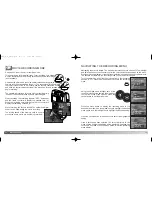
Always keep the strap around your
wrist in the event that the camera is
accidentally dropped.
Pass the small loop of the hand strap
through the strap eyelet
on the camera body (1).
Pass the other end of
the strap through the
small loop and tighten
(2).
12
13
G
ETTING UP AND RUNNING
GETTING UP AND RUNNING
INSTALLING BATTERIES
This digital camera uses two AA-size alkaline or Ni-MH batteries or one CR-V3 lithium
battery. Do not use other types of AA-size batteries. When using Ni-MH batteries, fully
recharge them with a battery charger suitable for complex electronic equipment. Before
using the batteries, read the safety warnings on page 3 of this manual.
When replacing the batteries, the camera should be turned off.
1
2
ATTACHING THE HAND STRAP
Open the battery-chamber door on the bottom of the
camera by sliding the door toward the side of the
camera (1) to release the safety catch; the door can
then be opened (2).
Insert the batteries as shown (3). Never force the
batteries.
Close the battery-chamber door (4) and slide it toward
the body (5) to engage the safety catch.
4
5
When using Ni-MH batteries, clean both battery terminals with dry cloth to wipe off any dirt or
residue. Because of the sophisticated computer system, the camera critically monitor power lev-
els. If the battery terminals are dirty, the camera may give a false battery-condition warning. If bat-
tery performance is unusually low, wipe the battery terminals with a clean, dry cloth.
Ni-MH battery performance will decrease if the batteries are often recharged before they have
been fully discharged. Completely exhaust the Ni-MH batteries using the camera before charg-
ing.
About Ni-MH batteries
1
The camera will reset if the batteries are removed for an
extended period. An internal battery protects the clock,
calendar, and camera settings for about 7 days if the
camera is used for at least two days before the batteries
are removed.
Camera Notes
2
3
+
-
2729_E_A_print.qxd 03.7.11 11:11 AM Page 12






































